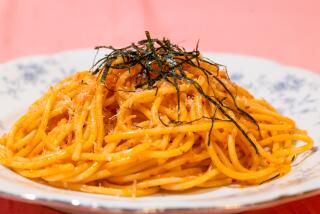FOOD : Sage Advice : New Possibilities for the Distinctive Flavor of This Mediterranean Herb
- Share via
IN RECENT DECADES relegated solely to the task of flavoring Thanksgiving turkey stuffing, sage is now being rediscovered as a year-round seasoning. It has a pungent flavor that, when used in abundance, can alienate more people than it pleases. But a light hand and a little creativity bring out the best in sage.
The name sage supposedly was derived from the Latin word salvere , meaning to save or to heal. Native to the Mediterranean, it was said to have medicinal properties that could cure such ailments as the common cold and epilepsy. By medieval times, people were adding sage to foods and sipping sage teas--they believed that the herb not only aided their general well-being but also imparted wisdom and improved memory. The Chinese so valued sage that they were willing to trade four units of tea for one unit of the herb.
Sage was introduced to this country in the early 19th Century. And until World War II it was the most popular American culinary herb, according to Frederic Rosengarten Jr., author of “The Book of Spices.” Following the war, sage lost its favored position to oregano and, more currently, basil.
Sage, when substituted for basil, creates a subtly flavored pesto variation to toss with linguine, shiitake mushrooms and dried tomatoes. Or slip fresh sage leaves under the skin of a turkey breast before roasting, then use minced leaves in a light sauce to enhance the sliced bird. Still another good use for sage is to chop the leaves and combine them with tomatoes, onion and garlic to make a sprightly salsa for garnishing miniature souffles. Whole sage leaves can be dusted with flour and fried, then layered in a horizontally sliced wheel of Brie or crumbled and used to flavor salads and sandwich fillings.
SAGE-FLAVORED TURKEY BREAST
1 (4- to 5-pound) turkey breast
1/4 ounce fresh whole sage leaves
Olive oil
Salt, pepper
2 tablespoons minced shallots
1 clove garlic, minced
1/4 cup dry white wine
Chicken broth
1 to 2 tablespoons minced fresh sage leaves
2 teaspoons cornstarch
2 teaspoons water
1 teaspoon lemon juice
Wash turkey breast and pat dry with paper towels. Loosen skin and insert sage leaves between skin and meat. Brush breast with olive oil and sprinkle with salt and pepper to taste. Place on rack in roasting pan.
Roast turkey breast at 325 degrees 1 3/4 to 2 hours, or until meat thermometer registers 170 degrees. Remove from oven, place turkey breast on serving platter, pour drippings into 2-cup measure and set aside.
Saute shallots and garlic in wine in small saucepan until tender. Skim fat from pan drippings and add enough chicken broth to measure 1 1/2 cups. Add chicken broth mixture and minced sage leaves to saucepan. Simmer 5 minutes.
Combine cornstarch and water. Stir into saucepan and simmer until slightly thickened. Add lemon juice. Serve with sliced turkey.
Makes 6 to 8 servings.
EGG TIMBALES WITH SAGE SALSA
1 1/2 cups diced tomato
1/3 cup minced onion
1 1/2 tablespoons minced fresh sage leaves
1 large clove garlic, minced
1 1/2 teaspoons balsamic vinegar
Olive oil
Salt
Cayenne pepper
8 eggs or 2 (8-ounce) cartons liquid-egg substitute
2 tablespoons minced green onion
Salt, pepper
Combine tomato, onion, sage, garlic, vinegar, 1 1/2 teaspoons olive oil and salt and cayenne to taste. Set aside.
Combine eggs, green onion and salt and pepper to taste. Brush 6 miniature souffle dishes with olive oil. Pour 1/3 cup egg mixture into each dish. Bake at 325 degrees 30 minutes or until set.
Remove eggs from oven and invert onto serving plate. Garnish with 1/4 cup salsa.
Makes 6 servings.
LINGUINE WITH SAGE PESTO
1 cup sage leaves
1/2 cup pine nuts
1 clove garlic, crushed
2 tablespoons grated Parmesan cheese
2 teaspoons lemon juice
Salt
White pepper
1/2 cup olive oil
12 ounces linguine
9 fresh shiitake mushrooms, sliced
1/2 cup marinated dried tomatoes, cut into pieces
1 tablespoon marinade from dried tomatoes
Toasted pine nuts
Combine sage leaves, 1/2 cup pine nuts, garlic, Parmesan, lemon juice and salt and white pepper to taste in blender or small food processor. Process until almost pureed. With motor running, drizzle olive oil into mixture through opening in lid or food chute.
Cook pasta al dente according to package directions. Saute mushrooms and dried tomatoes in tomato marinade until mushrooms are softened. Drain pasta and toss with pesto , mushrooms and tomatoes. Garnish with toasted pine nuts.
Makes about 6 servings.
FRIED SAGE LEAVES
1 ( 1/4-ounce) package fresh sage leaves
Flour
Oil
Wash sage leaves and dry very well. Dust sage leaves lightly with flour. Heat 1-inch oil in skillet. Drop sage leaves into hot oil and cook a few seconds until crisp. Remove immediately with slotted spoon. Drain on paper towels.
Note: Fat will spatter if too hot or if leaves are damp.
Food styled by Stephanie Puddy; photograph styling by Robin Tucker. Sage: Taylor Herb Gardens, Vista; tile: Globe Marble & Tile; tableware: Tesoro, Los Angeles; The Pavilion at Tanner Market, Pasadena, and Pottery Barn.
More to Read
Eat your way across L.A.
Get our weekly Tasting Notes newsletter for reviews, news and more.
You may occasionally receive promotional content from the Los Angeles Times.










